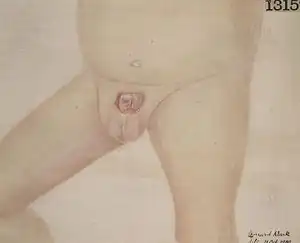Epispadias
| Epispadias | |
|---|---|
 | |
| Specialty | Urology |
| Symptoms | Males: Urethra opening on upper aspect of the penis, short penis[1] Females: Split clitoris, poorly formed mons pubis[1] |
| Complications | Urinary incontinence[1] |
| Usual onset | Present at birth[2] |
| Types | Males: Glandular, penile, penopubic[1] Females: Vestibular, sub-symphyseal, retro-symphyseal[1] |
| Causes | Unclear[1] |
| Differential diagnosis | Hypospadias, bladder exstrophy, common urogenital sinus[1] |
| Treatment | Surgery[1] |
| Frequency | Up to 1 in 10,000[1] |
Epispadias is a malformation in which the top of the urethra fails to close properly.[1] In males the opening of the urethra may occur on the upper aspect of the penis; which may be short and upward curved.[1] In females there may be a split clitoris and poorly formed mons pubis.[1] It often occurs in association with Bladder exstrophy.[1] Complications may include urinary incontinence.[1]
The cause is unclear.[1] The more severe forms of disease occur more commonly when there is a lack of folate before pregnancy.[1] Diagnosis is based on examination.[1] An X-ray is recommended to find associated pubic diastasis.[1]
Treatment may involved surgery.[1] Rates of incontinence range from 50 to 90%.[1] Epispadias may affect up to 1 in 10,000 people; though cases without bladder exstrophy are less than 1 in 100,000 males and 1 in 160,000 female births.[1]
Signs and symptoms
Most cases involve a small and bifid penis, which requires surgical closure soon after birth, often including a reconstruction of the urethra. Where it is part of a larger exstrophy, not only the urethra but also the bladder (bladder exstrophy) or the entire perineum (cloacal exstrophy) are open and exposed on birth, requiring closure. Many parts of this article are incorrect.
Associated conditions
Despite the similarity of name, an epispadias is not a type of hypospadias, and involves a problem with a different set of embryologic processes.
Women can also have this type of congenital malformation. Epispadias of the female may occur when the urethra develops too far anteriorly, exiting in the clitoris or even more forward. For females, this may not cause difficulty in urination but may cause problems with sexual satisfaction. Frequently, the clitoris is bifurcated at the site of urethral exit, and therefore clitoral sensation is less intense during sexual intercourse due to frequent stimulation during urination. However, with proper stimulation, using either manual or positional techniques, clitoral orgasm is definitely possible.
Causes
Epispadias is an uncommon and partial form of a spectrum of failures of abdominal and pelvic fusion in the first months of embryogenesis known as the exstrophy - epispadias complex. While epispadias is inherent in all cases of exstrophy it can also, much less frequently, appear in isolation as the least severe form of the complex spectrum. It occurs as a result of defective migration of the genital tubercle primordii to the cloacal membrane, and so malformation of the genital tubercle, at about the 5th week of gestation.
Treatment
The main treatment for isolated epispadias is a comprehensive surgical repair of the genito-urinary area usually during the first 7 years of life, including reconstruction of the urethra, closure of the penile shaft and mobilisation of the corpora. The most popular and successful technique is known as the modified Cantwell-Ransley approach. In recent decades however increasing success has been achieved with the complete penile disassembly technique despite its association with greater and more serious risk of damage.
Prognosis
Even with successful surgery, patients may have long-term problems with:
- incontinence, where serious usually treated with some form of continent urinary diversion such as the Mitrofanoff
- depression and psycho-social complications
- sexual dysfunction
References
- 1 2 3 4 5 6 7 8 9 10 11 12 13 14 15 16 17 18 19 20 21 Anand, S; Lotfollahzadeh, S (January 2021). "Epispadias". PMID 33085327.
{{cite journal}}: Cite journal requires|journal=(help) - ↑ "Bladder Exstrophy-Epispadias-Cloacal Exstrophy Complex". NORD (National Organization for Rare Disorders). Archived from the original on 23 January 2021. Retrieved 21 May 2021.
External links
| Classification | |
|---|---|
| External resources |